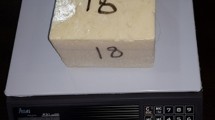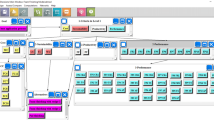Abstract
In this work, the management of a polyurethane foam plant is tackled through a mixed integer linear programming model that simultaneously solves production and inventory planning problems. The production process considers the foaming stage where large polyurethane blocks are produced as well as the curing step where the blocks are dried. The proposed formulation takes into account several tradeoffs involved in the overall production process. The daily production planning is tightly related to production requirements, available space for the curing and stored elements. Moreover, the required time to dry blocks introduces a delay that must be appropriately considered in order to allow an adequate operation of downstream operations. Thus, an integrated approach where all these problems are jointly addressed is proposed using a mathematical programming model. Several study cases provided by a local company are tested to demonstrate the model performance.





Similar content being viewed by others
Abbreviations
- i :
-
Block widths
- j :
-
Block densities
- k :
-
Block lengths
- h :
-
Rows in the curing area
- g :
-
Groups of blocks
- Blocks :
-
Set of possible foam blocks of width i, density j, and length k
- \(Cart\) :
-
Set of long blocks that can be cured on special carts since they have a low density j
- \(Long\) :
-
Set of long blocks
- \(Orders\) :
-
Set of special orders to produce blocks of width i, density j, and length k that are made to order
- \(Groups\) :
-
Set of blocks of width i, density j, and length k belonging to groups g
- \(dif_{ijk}\) :
-
The difference between the final stock and the minimal stock for the block of width i, density j and length k
- \(sf_{ijk}\) :
-
Final stock for the block of width i, density j and length k
- \(sm_{ijk}\) :
-
Intermediate stock for the block of width i, density j and length k
- \(u_{ijk}\) :
-
Indicates if there is no unsatisfied demand for the block of width i, density j and length k
- \(w_{jh}\) :
-
Indicates if density j is produced and assigned to be cured in row h
- \(x_{ijk}\) :
-
Indicates if external order blocks of width i, density j and length k are produced
- \(y_{i}\) :
-
Indicates if the width i is selected to be produced
- \(z_{jkh}\) :
-
Indicates if any block of density j and length k is placed on row h
- \(n_{ijkh}\) :
-
Number of blocks produced of width i, density j, and length k, placed in row h
- \(n1_{ijkh}\) :
-
Number of long blocks of width i and density j cured on the special carts (note that the purpose of keeping index h in this variable is given by Eq. (7) but it has no physical meaning)
- \(n2_{ijkh}\) :
-
Number of long blocks of width i and density j placed on row h of the floor
- \(BM_{o}\) :
-
“Big M” parameter, where o = 0, 1, 2,…,7
- \(cw_{i}\) :
-
Width of the curing area when width i is selected
- \(cl_{i}\) :
-
Length of the curing area when width i is selected
- \(d_{ijk}\) :
-
Demand for blocks of width i, density j, and length k
- \(fl_{ijk}\) :
-
Length of block of width i, density j, and length k occupied on the floor in the curing stage
- \(bw_{i}\) :
-
Width of blocks from set i
- \(fs\) :
-
Minimal space that must be left between blocks to allow air flow in the curing area
- \(l_{ijk}\) :
-
Length of block of width i, density j, and length k
- \(l\_min\) :
-
Minimal length to produce for each density
- \(ml_{i}\) :
-
Minimal length to be produced for width i
- \(np\) :
-
Number of places available in the carts for the curing stage of long blocks
- \(Rows_{i}\) :
-
Number of available rows in the curing area when width i is selected
- \(s_{ijk}\) :
-
Number of blocks of width i, density j, and length k in stock at the beginning of the day
- \(sc_{g}\) :
-
Stock capacity of group g
- \(smax_{ijk}\) :
-
Maximal stock level (stock capacity) for block of width i, density j, and length k
- \(smin_{ijk}\) :
-
Minimal stock level for block of width i, density j, and length k
- \(soq_{ijk}\) :
-
Number of special blocks ordered of width i, density j, and length k
References
Bernardini J, Cinelli P, Anguillesi I et al (2014) Flexible polyurethane foams green production employing lignin or oxypropylated lignin. Eur Polym J 64:147–156. doi:10.1016/j.eurpolymj.2014.11.039
Cafaro DC, Cerdá J (2016) Short-term operational planning of refined products pipelines. Optim Eng. doi:10.1007/s11081-016-9330-5
Chu Y, You F (2014) Moving horizon approach of integrating scheduling and control for sequential batch processes. AIChE J 60:1654–1671. doi:10.1002/aic.14359
Engels H-W, Pirkl H-G, Albers R et al (2013) Polyurethanes: versatile materials and sustainable problem solvers for today’s challenges. Angew Chem Int Ed Engl 52:9422–9441. doi:10.1002/anie.201302766
Fumero Y, Corsano G, Montagna JM (2011) Planning and scheduling of multistage multiproduct batch plants operating under production campaigns. Ann Op Res 199:249–268. doi:10.1007/s10479-011-0954-8
Fumero Y, Corsano G, Montagna JM (2013) Integrated modeling framework for supply chain design considering multiproduct production facilities. Ind Eng Chem Res 52:16247–16266. doi:10.1021/ie400579g
Grossmann IE (2012) Advances in mathematical programming models for enterprise-wide optimization. Comput Chem Eng 47:2–18. doi:10.1016/j.compchemeng.2012.06.038
Harjunkoski I, Maravelias CT, Bongers P et al (2014) Scope for industrial applications of production scheduling models and solution methods. Comput Chem Eng 62:161–193. doi:10.1016/j.compchemeng.2013.12.001
Hopmann C, Latz S (2014) Foaming technology using gas counter pressure to improve the flexibility of foams by using high amounts of CO2 as a blowing agent. Polymer (Guildf) 56:29–36. doi:10.1016/j.polymer.2014.09.075
Jain V, Grossmann IE (2000) A disjunctive model for scheduling in a manufacturing and packing facility with intermediate storage. Optim Eng 1:215–231. doi:10.1023/A:1010095932721
Lanoë T, Simões CL, Simoes R (2013) Improving the environmental performance of bedding products by using life cycle assessment at the design stage. J Clean Prod 52:155–164. doi:10.1016/j.jclepro.2013.03.013
Lin X, Floudas CA (2003) A novel continuous-time modeling and optimization framework for well platform planning problems. Optim Eng 4:65–95. doi:10.1023/A:1021860330145
Lin BMT, Lin Y-Y, Fang K-T (2013) Two-machine flow shop scheduling of polyurethane foam production. Int J Prod Econ 141:286–294. doi:10.1016/j.ijpe.2012.08.006
Maravelias CT, Sung C (2009) Integration of production planning and scheduling: overview, challenges and opportunities. Comput Chem Eng 33:1919–1930. doi:10.1016/j.compchemeng.2009.06.007
Marchetti PA, Gupta V, Grossmann IE et al (2014) Simultaneous production and distribution of industrial gas supply-chains. Comput Chem Eng 69:39–58. doi:10.1016/j.compchemeng.2014.06.010
Mogaji PB (2014) A decision support system for process planning and control of polyurethane foam production. J Comput Eng Inf Technol 3:1–7
Ortega M, Lin L (2004) Control theory applications to the production–inventory problem: a review. Int J Prod Res 42:2303–2322. doi:10.1080/00207540410001666260
Relvas S, Boschetto Magatão SN, Barbosa-Póvoa APFD, Neves F (2013) Integrated scheduling and inventory management of an oil products distribution system. Omega 41:955–968. doi:10.1016/j.omega.2013.01.001
Rodriguez MA, Vecchietti A (2010) Inventory and delivery optimization under seasonal demand in the supply chain. Comput Chem Eng 34:1705–1718
Strack G, Pochet Y (2010) An integrated model for warehouse and inventory planning. Eur J Op Res 204:35–50. doi:10.1016/j.ejor.2009.09.006
Subramanian K, Rawlings JB, Maravelias CT (2014) Economic model predictive control for inventory management in supply chains. Comput Chem Eng 64:71–80. doi:10.1016/j.compchemeng.2014.01.003
Trespalacios F, Grossmann IE (2016) Symmetry breaking for generalized disjunctive programming formulation of the strip packing problem. Ann Op Res. doi:10.1007/s10479-016-2112-9
Verlinden B, Cattrysse D, Crauwels H, Van Oudheusden D (2009) The development and application of an integrated production planning methodology for sheet metal working SMEs. Prod Plan Control Manag Op 20:649–663
Wäscher G, Haußner H, Schumann H (2007) An improved typology of cutting and packing problems. Eur J Op Res 183:1109–1130. doi:10.1016/j.ejor.2005.12.047
Acknowledgement
The authors would like to acknowledge Limansky S.A. for their financial support as well as the information provided to test the mathematical models. We also appreciated financial support from CONICET, Universidad Tecnologica Nacional and ANPCyT to develop the research activities through their projects PIP 0682, PID 25/O152 and PICT-2012-2484, respectively.
Author information
Authors and Affiliations
Corresponding author
Rights and permissions
About this article
Cite this article
Rodriguez, M.A., Corsano, G., Vecchietti, A. et al. Simultaneous optimization of production planning and inventory management of polyurethane foam plant. Optim Eng 19, 97–123 (2018). https://doi.org/10.1007/s11081-017-9364-3
Received:
Revised:
Accepted:
Published:
Issue Date:
DOI: https://doi.org/10.1007/s11081-017-9364-3




